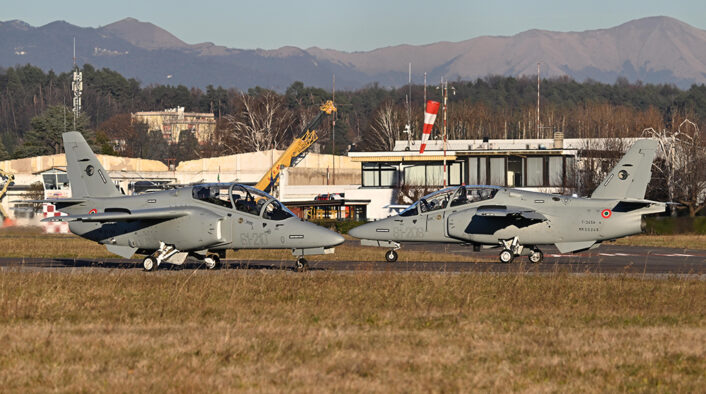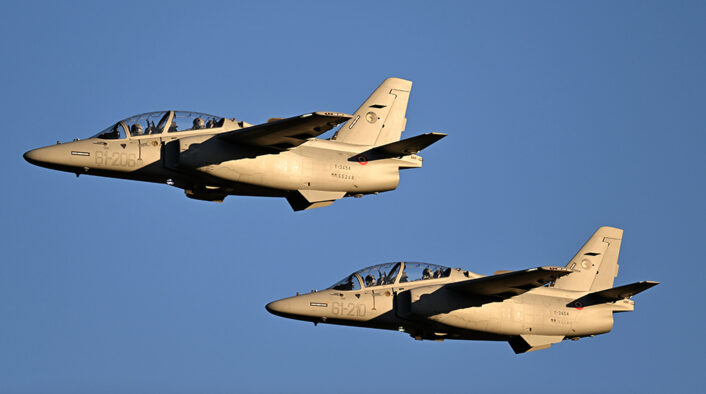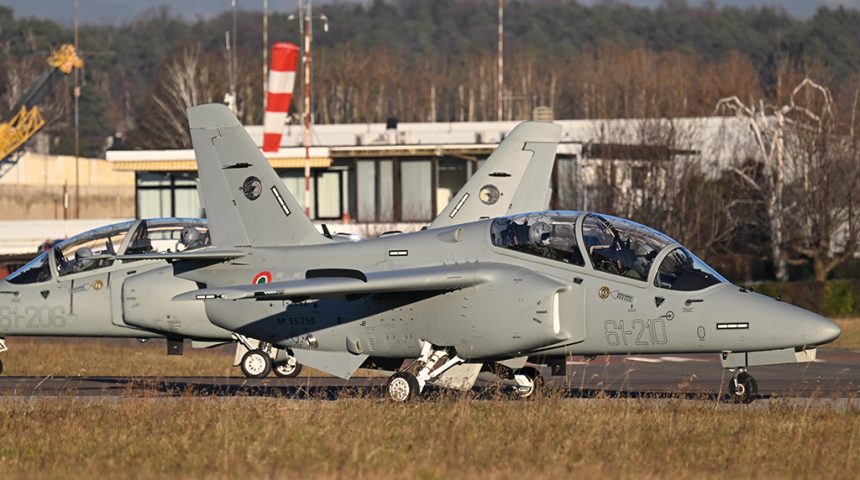Two T-345A aircraft have deployed to Pratica di Mare Air Base, near Rome, where they will be flown by the RSV (Reparto Sperimentale Volo) of the Italian Air Force.
On Dec. 19, 2023, two new Leonardo T-345 trainers with the markings of the 61° Stormo (Wing), the Italian Air Force Flight School, based at Lecce-Galatina Airbase, in southeastern Italy, took off from Venegono airport, where the final assembly line of Leonardo Aircraft is located, to deploy to Pratica di Mare AB, near Rome, to join the RSV, the Test Wing of the ItAF.
In the hands of the test pilots of the 311° Gruppo (Squadron), the two T-345s, MM55248/61-206 and MM55250/61-210, will undertake the flight testing activity required before delivery to the 61st Wing.

The T-345 (local designation of the M-345) is an airframe based on the S-211 trainer, redesigned with improved aerodynamics, reinforced airframe, new cockpit and avionics and called initially M-311, before assuming the final name as M-345 High Efficiency Trainer. The aircraft, which shares also some parts with the M-346 Master (T-346A in Italian service), is powered by a Williams FJ44-4M-34 turbofan engine with 1,540 kg (3,400 lb) of thrust, can fly up to 40’000 ft with load factors of +7/-3.5 g and a max speed of 380 KTAS at sea level or 425 KTAS at 20,000 ft. The max range is reported as 760 nm in clean configuration and 1,000 NM with external fuel tanks.
The Italian Air Force ordered 18 M-345As (a number that might increase) to replace the ageing MB-339s in the Phase 2 and Phase 3 training, during which students obtain their Military Pilot Licenses before moving to Phase 4, the Lead-In Fighter Training with the T-346A Master.
Some time around 2030 (when the support contract for the MB-339 expires) or even before, the T-345 should also become the new platform of the Italian Air Force’s Frecce Tricolori display team.
After the first T-345s, MM55234/61-202 and MM55235/61-20, were delivered to the Italian Air Force in December 2020, Leonardo started to work on the fixes required to address the type’s teething issues and fine tune some of the aircraft’s systems. The delivery of the new airframes to the RSV is the first step towards the resumption of the normal deliveries and the development of the new syllabus.
As already explained in details here:
The T-345 will gradually replace the MB-339s, beginning from the A variant and later continuing with the CD variant. In fact, thanks to its characteristics, the aircraft can be used for the entire training syllabus, from the Primary Pilot Training to the Specialized Pilot Training.
The T-345 will bring multiple advantages. Similarly to the M346, the new aircraft will be part of an integrated netcentric system, which will allow to shrink the time needed for the training while improving its quality and efficiency. The T-345 trainer offers performance typical of a jet aircraft, such as the maximum altitude and speed, with operational costs comparable to the ones of a turboprop aircraft.
The T-345 is equipped with simple and essential onboard systems, which require minimum maintenance and allow the maximum safety and reliability. The Williams FJ44-4M-34 turbofan engine is equipped with a modern digital control system and provides a good thrust with low fuel consumption. The acquisition costs are comparable to the ones of turboprop trainers, allowing a long service life of 15,000 flight hours.
The swept high wing provides a greater maneuverability and an easier recovery from dangerous attitudes, while its profile also creates a higher lift. The aircraft is equipped with the latest technologies, such as touchscreen multi-functional displays, exposing the students to these technologies, similar to the ones of front-line aircraft, early in the training, so they can gradually improve their competencies with such advanced avionics before reaching the OCUs.










